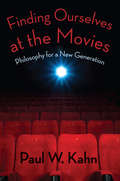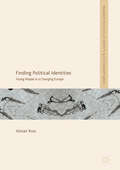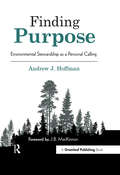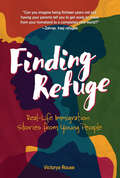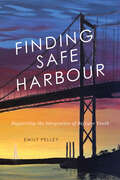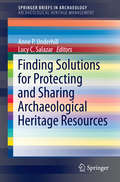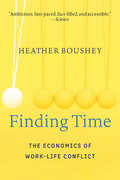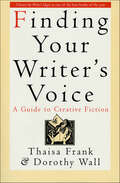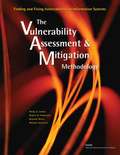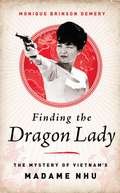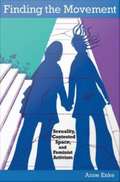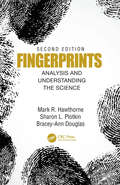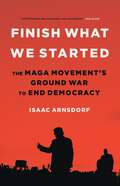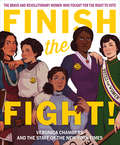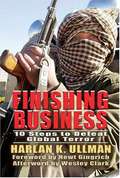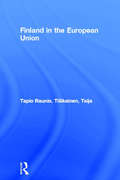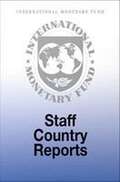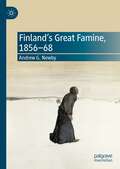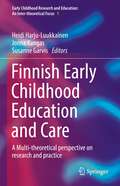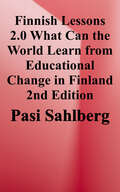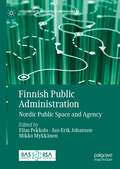- Table View
- List View
Finding Ourselves at the Movies: Philosophy for a New Generation
by Paul KahnAcademic philosophy may have lost its audience, but the traditional subjects of philosophy—love, death, justice, knowledge, and faith—remain as compelling as ever. To reach a new generation, Paul W. Kahn argues that philosophy must take up these fundamental concerns as we find them in contemporary culture. He demonstrates how this can be achieved through a turn to popular film.Discussing such well-known movies as Forrest Gump (1994), The American President (1995), The Matrix (1999), Memento (2000), The History of Violence (2005), Gran Torino (2008), The Dark Knight (2008), The Road (2009), and Avatar (2009), Kahn explores powerful archetypes and their hold on us. His inquiry proceeds in two parts. First, he uses film to explore the nature of action and interpretation, arguing that narrative is the critical concept for understanding both. Second, he explores the narratives of politics, family, and faith as they appear in popular films. Engaging with genres as diverse as romantic comedy, slasher film, and pornography, Kahn explores the social imaginary through which we create and maintain a meaningful world. He finds in popular films a new setting for a philosophical inquiry into the timeless themes of sacrifice, innocence, rebirth, law, and love.
Finding Political Identities: Young People in a Changing Europe (Palgrave Politics of Identity and Citizenship Series)
by Alistair RossThis book examines how young people in Europe construct their political identities. Based on small discussion groups with 2000 young people across 29 European states, Alistair Ross explores how 13 to 20 year olds build identities in contemporary society, creating contingent narratives of local, national and European identities with families, friends and social media. As well as exploring what these kaleidoscopic identities look like and the sources they draw on, it also examines how these accounts are assembled and integrated with each other. The study uses deliberative discussions to allow young people to develop their own constructs and terms in conversation with each other. This analysis presents a complex polyphonic of political beliefs and values of rights, which young Europeans attach to political structures and institutions that often transcend traditional boundaries of state and nation. Finding Political Identities will be of interest to postgraduate students and academics across Education, Sociology, Politics and European Studies, especially those with a focus on Social Constructionism, Citizenship, Identity Studies, Social Policy, and Youth Studies.
Finding Purpose: Environmental Stewardship as a Personal Calling
by Andrew J. HoffmanBoth thoughtful and thought-provoking, Finding Purpose aims to challenge our understanding of how humanity interacts with planet Earth, and our role within this. This book is an invitation: would you like to participate in one of the most important projects of imagination, perhaps the greatest ever, in human history? Distilling and refining over 20 pieces from a lifetime of work in academia and trade, across speeches, blogs, editorials and essays, Hoffman invites us to look beyond material growth and explore the role of the individual and business in discovering a wider purpose to bring about a balanced and sustainable society. The reader is encouraged to consider humanity’s relationship with the environment through different lenses: business, academia, faith-based and cultural. By bringing them together, Hoffman encourages us to understand our relationship with the planet in a far more holistic sense. Drawing on ideas from philosophy, literature, natural sciences and politics, Hoffman ensures that the ideas he explores are wholly accessible and applicable. Fully substantiated through various research and examples, the issues described are consistently made relevant to the reader.Finding Purpose is the perfect book for anyone – from student to CEO – thinking about their place in the world, and how making changes in our own lives and societies can impact on the world around us.
Finding Refuge: Real-Life Immigration Stories from Young People
by Victorya RouseWhen you read about war in your history book or hear about it in the news, do you ever wonder what happens to the families and children in the places experiencing war? Many families in these situations decide that they must leave their homes to stay alive. What happens to them? According to the United Nations High Commissioner for Refugees, 70.8 million people around the world have been forced to leave their homes because of war or persecution as of 2019. Over fifty percent of these people are under the age of eighteen. English teacher Victorya Rouse has assembled a collection of real-world experiences of teen refugees from around the world. Learn where these young people came from, why they left, and how they arrived in the United States. Read about their struggles to adapt to a new language, culture, and high school experiences, along with updates about how they are doing now and what they hope their futures will look like. As immigration has catapulted into the current discourse, this poignant collection emphasizes the United States' rich tradition of welcoming people from all over the world.
Finding Safe Harbour: Supporting Integration of Refugee Youth (McGill-Queen's Refugee and Forced Migration Studies #8)
by Emily PelleyThe global refugee crisis is staggering in scope. The United Nations Refugee Agency reported that 79.5 million people were displaced worldwide in 2019, and over half of all displaced persons were under eighteen.As the number of children and teenagers seeking asylum continues to grow, the impact of displacement on a young person’s well-being and development over the long term requires further study. In Finding Safe Harbour Emily Pelley investigates the current response to refugee youth in Canada by highlighting how Halifax, Nova Scotia, as a mid-sized urban centre, has mobilized services and resources to support young people seeking refuge. Opening with a broad contextual introduction to the global crisis of displacement and the impact of violence and armed conflict on young people, Pelley focuses on the reciprocal adaptation that is required for the long-term integration of displaced youth into the receiving society.A concise and illuminating study on refugee resettlement, Finding Safe Harbour concludes with an in-depth discussion of how cities can optimize resilience resources through meaningful engagement with refugee youth.
Finding Solutions for Protecting and Sharing Archaeological Heritage Resources
by Anne P. Underhill Lucy C. SalazarThis volume provides case studies about successful strategies employed in diverse world areas for the protection of archaeological heritage resources. Some chapters focus on a search for solutions arrived at by diverse groups of people working in specific areas rather than simply describing loss of cultural heritage. Other chapters provide a long-term view of intensified efforts at protection of archaeological resources. The authors describe challenges and solutions derived by concerned people in eastern Asia (China, Japan, Thailand), West Africa, Easter Island, Jordan, Honduras and more than one area of Peru. All of the authors draw upon deep, personal involvement with the protection of cultural heritage in each area. This volume is a timely addition to a growing number of conferences and publications about the management of cultural heritage--both archaeological and historical.
Finding The Middle Path: The Political Economy Of Cooperation In Rural India
by B. S. BaviskarSoviet-style socialism has failed; but in Russia, China, and India the transition to capitalism has proven hazardous. Elsewhere, capitalism itself appears to be in crisis, often failing to meet the fundamental needs of workers, small farmers, and even the middle classes. Clearly, the world needs enterprises that are both economically efficient and
Finding Time: The Economics of Work-Life-Conflict
by Heather BousheyEmployers demand more of employees' time while leaving the important things in life--health, family--for workers to take care of on their own time and dime. How can workers get ahead while making sure their families don't fall behind? Heather Boushey shows in detail that economic efficiency and equity do not have to be enemies.
Finding Your Writer's Voice: A Guide to Creative Fiction
by Thaisa Frank Dorothy WallAn illuminating guide to finding one's most powerful writing tool, Finding Your Writer's Voice helps writers learn to hear the voices that are uniquely their own. Mixing creative inspiration with practical advice about craft, the book includes chapters on:Accessing raw voiceListening to voices of childhood, public and private voices, and colloquial voicesWorking in first and third person: discovering a narrative personaUsing voice to create charactersShaping one's voice into the form of a storyReigniting the energy of voice during revision
Finding and Fixing Vulnerabilities in Information Systems
by Philip S. Anton Michael Scheiern Richard Mesic Robert H. AndersonUnderstanding an organization's reliance on information systems and how to mitigate the vulnerabilities of these systems can be an intimidating challenge--especially when considering less well-known weaknesses or even unknown vulnerabilities that have not yet been exploited. The authors introduce the Vulnerability Assessment and Mitigation methodology, a six-step process that uses a top-down approach to protect against future threats and system failures while mitigating current and past threats and weaknesses.
Finding the Dragon Lady: The Mystery of Vietnam's Madame Nhu
by Monique Brinson DemeryA quest for one of historyOCOs most controversial figures?the woman, known everywhere in her day as the Dragon Lady, who was a lightning rod for AmericaOCOs toxic involvement in Vietnam She was ?the beautiful but diabolic sex dictatressOCO according to the journalist David Halberstam; everything Jack found unattractiveOCO in the words of Jacqueline Kennedy; ?the most dangerous enemy a man can haveOCO in Malcolm BrowneOCOs view; and everywhere in the media in the 1960s she was the ?Dragon Lady. OCO Monique DemeryOCOs search for the woman behind all the epithets, claims, and counterclaims?a woman who had been living in exile and seclusion for thirty years?began on the streets of Paris and deepened when she began a relationship with, and was entrusted with the unpublished memoirs of, Tran Le Xuan, otherwise known as Madame Nhu, the First Lady of the doomed republic of South Vietnam. Madame NhuOCOs diminutive beauty cannot obscure her pivotal role in one of American historyOCOs darkest moments: she was much of the reason that the United States made the fateful decision to get rid of the ruling Ngo family. Demery investigates the reality behind the myth, giving us a deeper look at the woman who was feared and despised by so much of the world, one of the most memorable figures of the entire Vietnam War.
Finding the Movement: Sexuality, Contested Space, and Feminist Activism
by Anne EnkeIn Finding the Movement, Anne Enke reveals that diverse women's engagement with public spaces gave rise to and profoundly shaped second-wave feminism. Focusing on women's activism in Detroit, Chicago, and Minneapolis-St. Paul during the 1960s and 1970s, Enke describes how women across race and class created a massive groundswell of feminist activism by directly intervening in the urban landscape. They secured illicit meeting spaces and gained access to public athletic fields. They fought to open bars to women and abolish gendered dress codes and prohibitions against lesbian congregation. They created alternative spaces, such as coffeehouses, where women could socialize and organize. They opened women-oriented bookstores, restaurants, cafes, and clubs, and they took it upon themselves to establish women's shelters, health clinics, and credit unions in order to support women's bodily autonomy. By considering the development of feminism through an analysis of public space, Enke expands and revises the historiography of second-wave feminism. She suggests that the movement was so widespread because it was built by people who did not identify themselves as feminists as well as by those who did. Her focus on claims to public space helps to explain why sexuality, lesbianism, and gender expression were so central to feminist activism. Her spatial analysis also sheds light on hierarchies within the movement. As women turned commercial, civic, and institutional spaces into sites of activism, they produced, as well as resisted, exclusionary dynamics.
Fingerprints: Analysis and Understanding the Science
by Mark R. Hawthorne Sharon L. Plotkin Bracey-Ann DouglasFingerprints: Analysis and Understanding the Science, Second Edition is a thorough update of Mark Hawthorne’s classic written by two professionals with combined experience not only in crime scene investigations but also as court-recognized experts in latent print examination. Designed as a concise text to cover the fundamental techniques and principles of obtaining and analyzing latent fingerprint evidence, the book is laid out and written in an easy to understand format for those front-line professionals collecting and analyzing fingerprint evidence. Over time, the degree of sophistication and education on fingerprints and friction ridge analysis has increased. Ultimately, through scientific study by pioneers in the field, the composition of friction skin soon became evident: that it could be used as a unique identifier of individuals. Now, fingerprints and footprints as unique identifiers—and their use in criminal cases—have become commonplace and an essential component of criminal investigation with most cases involving some component of fingerprint evidence. Divided into two parts, the book begins with the basics of analysis, providing a brief history, systematic methods of identification, fingerprint pattern types and their associated terminologies and current classifications. The second part of the book discusses the identification and presentation of evidence in the courtroom, demonstrating both the traditional, manual method of lifting prints and the newer techniques for automated and live scans. Coverage provides instruction on searching and developing latent prints, storage, and comparison of prints. New to this edition are updated techniques on collecting and preserving fingerprint evidence—including packaging and maintaining chain of custody. More detailed documentation processes, and additional chemical and lifting techniques, are described including use of light sources, latent backing cards and lifting material, casting material, ten print cards, and the enhancement of prints in blood. A discussion of laboratory equipment and comparison tools, the addition of photography techniques, and recent courtroom challenges to fingerprint evidence is also presented. Fingerprints, Second Edition will provide a hands-on, fresh look at the most commonly utilized evidence found at crime scenes: fingerprints. The book will provide law enforcement, crime scene personnel and students just such an opportunity to easily understand and grasp the concepts, and relevant issues, associated with friction skin and fingerprint evidence.
Finish What We Started: The MAGA Movement's Ground War to End Democracy
by Isaac Arnsdorf"Entertaining, enlightening and disturbing." - Ira GlassThe immersive, captivating untold story of the mass radicalization of the Republican Party in the aftermath of January 6, 2021, entrenching the political power of a radical right-wing movement dedicated to dismantling democracy itself. Inspired by Donald Trump&’s election lies, a growing movement of grassroots activists mobilized around the country to pick up where the insurrection left off, laying the groundwork to succeed next time where Trump had failed to keep himself in power. But their own success in taking over and purging the Republican Party became their undoing as it drove away moderates and supplied the Democrats with a winning message in the 2022 midterms. Still, the MAGA Republicans proved uninterested in learning from that defeat, only becoming more extreme, divisive, and dead set on returning Trump to power. Washington Post national political reporter Isaac Arnsdorf has spent years at the forefront of reporting on this growing movement. Drawing on extensive, exclusive on-the-ground reporting around the country, and deepened by historical context, Arnsdorf has produced the defining journalistic account of the origins, evolution and future of the MAGA movement. Combining critical and rigorous reporting with the intimacy and complexity of a novel, this book is unlike any other in the decade since Donald Trump convulsed and transformed American politics. Finish What We Started tells the story of the ordinary Americans driving this change, who they are and where they came from, what motivates them, and what their movement means for the survival of American democracy.
Finish the Fight!: The Brave and Revolutionary Women Who Fought for the Right to Vote
by Veronica Chambers The Staff of The New York TimesWho was at the forefront of women's right to vote? We know a few famous names, like Susan B. Anthony and Elizabeth Cady Stanton, but what about so many others from diverse backgrounds—black, Asian, Latinx, Native American, and more—who helped lead the fight for suffrage? On the hundredth anniversary of the historic win for women's rights, it's time to celebrate the names and stories of the women whose stories have yet to be told. Gorgeous portraits accompany biographies of such fierce but forgotten women as Yankton Dakota Sioux writer and advocate Zitkála-Šá, Mary Eliza Church Terrell, who cofounded the National Association of Colored Women (NACW), and Mabel Ping-Hua Lee, who, at just sixteen years old, helped lead the biggest parade in history to promote the cause of suffrage. FINISH THE FIGHT will fit alongside important collections that tell the full story of America's fiercest women. Perfect for fans of GOOD NIGHT STORIES FOR REBEL GIRLS and BAD GIRLS THROUGHOUT HISTORY.
Finishing Business: Ten Steps to Defeat Global Terror
by Harlan K. UllmanUllman examines the underlying causes and political motivations that drive global terrorism. He analyzes the attraction that Jihadist Extremism holds for disaffected Muslims around the world and argues that American governance is currently not up to the task of keeping the nation safe. He then describes ten concrete steps America can take to defeat global terror. Ullman is a columnist for the Washington Times.
Finland in the European Union
by Teija Tiilikainen Tapio RaunioWith a focus on governmental institutions, this book explores the ways in which EU membership has altered the balance of power among key political actors. The authors discuss cultural adaptation to integration, as well as examining the views of the elite and voters. The transformation in national identity, sovereignty and neutrality are also examined.
Finland: Report on the Observance of Standards and Codes--FATF Recommendations for Anti-Money Laundering and Combating the Financing of Terrorism
by International Monetary FundA report from the International Monetary Fund.
Finland: Selected Issues
by International Monetary FundA report from the International Monetary Fund.
Finland: Selected Issues
by International Monetary FundA report from the International Monetary Fund.
Finland’s Famous Education System: Unvarnished Insights into Finnish Schooling
by Martin Thrupp Jaakko Kauko Piia Seppänen Sonja KosunenThis open access book provides academic insights and serves as a platform for research-informed discussion about education in Finland. Bringing together the work of more than 50 authors across 28 chapters, it presents a major collection of critical views of the Finnish education system and topics that cohere around social justice concerns. It questions rhetoric, myths, and commonly held assumptions surrounding Finnish schooling.This book draws on the fields of sociology of education, education policy, urban studies, and policy sociology. It makes use of a range of research methodologies including ethnography, case study and discourse analysis, and references the work of relevant theorists, including Bourdieu and Foucault. This book aims to provide a critical, updated and astute analysis of the strengths and challenges of the Finnish education system.
Finland’s Great Famine, 1856-68
by Andrew G. NewbyThis book will provide a thematic overview of one of European history’s most devastating famines, the Great Finnish Famine of the 1860s. In 1868, the nadir of several years of worsening economic conditions, 137,000 people (approximately 8% of the Finnish population) perished as the result of hunger and disease. The attitudes and policies enacted by Finland’s devolved administration tended to follow European norms, and therefore were often similar to the “colonial” practices seen in other famines at the time. What is distinctive about this catastrophe in a mid-nineteenth-century context, is that despite Finland being a part of the Russian Empire, it was largely responsible for its own governance, and indeed was developing its economic, political and cultural autonomy at the time of the famine. Finland’s Great Famine 1856-68 examines key themes such as the use of emergency foods, domestic and overseas charity, vagrancy and crime, emergency relief works, and emigration.
Finnish Early Childhood Education and Care: A Multi-theoretical perspective on research and practice (Early Childhood Research and Education: An Inter-theoretical Focus #1)
by Susanne Garvis Heidi Harju-Luukkainen Jonna KangasThis book highlights contemporary questions around Early Childhood Education in Finland. It explores a range of issues relating to policies and practices in Early Childhood Education and Care (ECEC). The book features many aspects of the so-called Nordic model that is evident in different practices and policies of the Finnish ECEC system. Among others topics, it discusses playful learning, storycrafting, scientific literacy, pedagogical leadership, family-related variables, and Sami language learning. The findings provide important insights into the Finnish ECEC model and illustrate relevant issues facing Finland. All of the 14 chapters present unique research and give the reader the opportunity to understand how the ECEC services during children’s early years are defined and implemented. Each chapter includes a discussion of the educational outcome and highlights critical perspectives. In Finland ECEC is seen as an investment in the future. The Finnish ECEC system is one of the most equal in the world. The high-quality education is available to both private and public sectors. National curriculum and laws for early education have gone through a significant reform during the last decade, with the quality, practices and teachers’ competences being defined in order to support children’s future learning skills. ECEC in Finland is a unique combination of international influences and local intentions to put each child and family at the centre of the services. The systematic and goal-oriented ECEC system consists of upbringing, education and care with an emphasis on pedagogy in order to produce excellence for the future. Its overall planning, guidance and monitoring system is one of a kind.
Finnish Lessons 2. 0: What Can the World Learn from Educational Change in Finland?
by Pasi SahlbergWith Finnish Lessons 2.0, the author Pasi Sahlberg has thoroughly updated his groundbreaking account of how Finland built a world-class education system during the past four decades. <p><p>In this international bestseller, the author traces the evolution of Finnish education policies and highlights how they differ from the United States and much of the rest of the world. Featuring substantial additions throughout the text, Finnish Lessons 2.0 demonstrates how systematically focusing on teacher and leader professionalism, building trust between the society and its schools, and investing in educational equity rather than competition, choice, and other market-based reforms make Finnish schools an international model of success. <p><p>This second edition details the complexity of meaningful change by examining Finland's educational performance in light of the most recent international assessment data and domestic changes. In the midst of continuous local reforms and global changes, Finnish Lessons 2.0 encourages educators, students, and policymakers to look beyond their own borders as they seek successful solutions for their education systems, districts, and schools.
Finnish Public Administration: Nordic Public Space and Agency (Governance and Public Management)
by Jan-Erik Johanson Elias Pekkola Mikko MykkänenThis book provides a comprehensive analysis of public administration in Finland. Many of the basic structures of Finnish public administration have remained intact during the country’s relatively short independence of 100 years, but Finland has been able to tackle major turbulence ranging from wars and financial crises to the Covid-19 pandemic. Finland has also had to adjust to greater European integration, a new constitution, an ageing population, increased globalization of markets, and climate change. Chapters in this volume examine a wide range of themes pertinent to Finnish public administration, including government, regionalisation, health care policy, performance management, budgeting, and higher education policy. Placing these themes within the wider context of Nordic administrative developments, the book showcases public administration in Finland as pragmatism in action. It will appeal to students and scholars of public administration, public management, public policy and Nordic studies.
